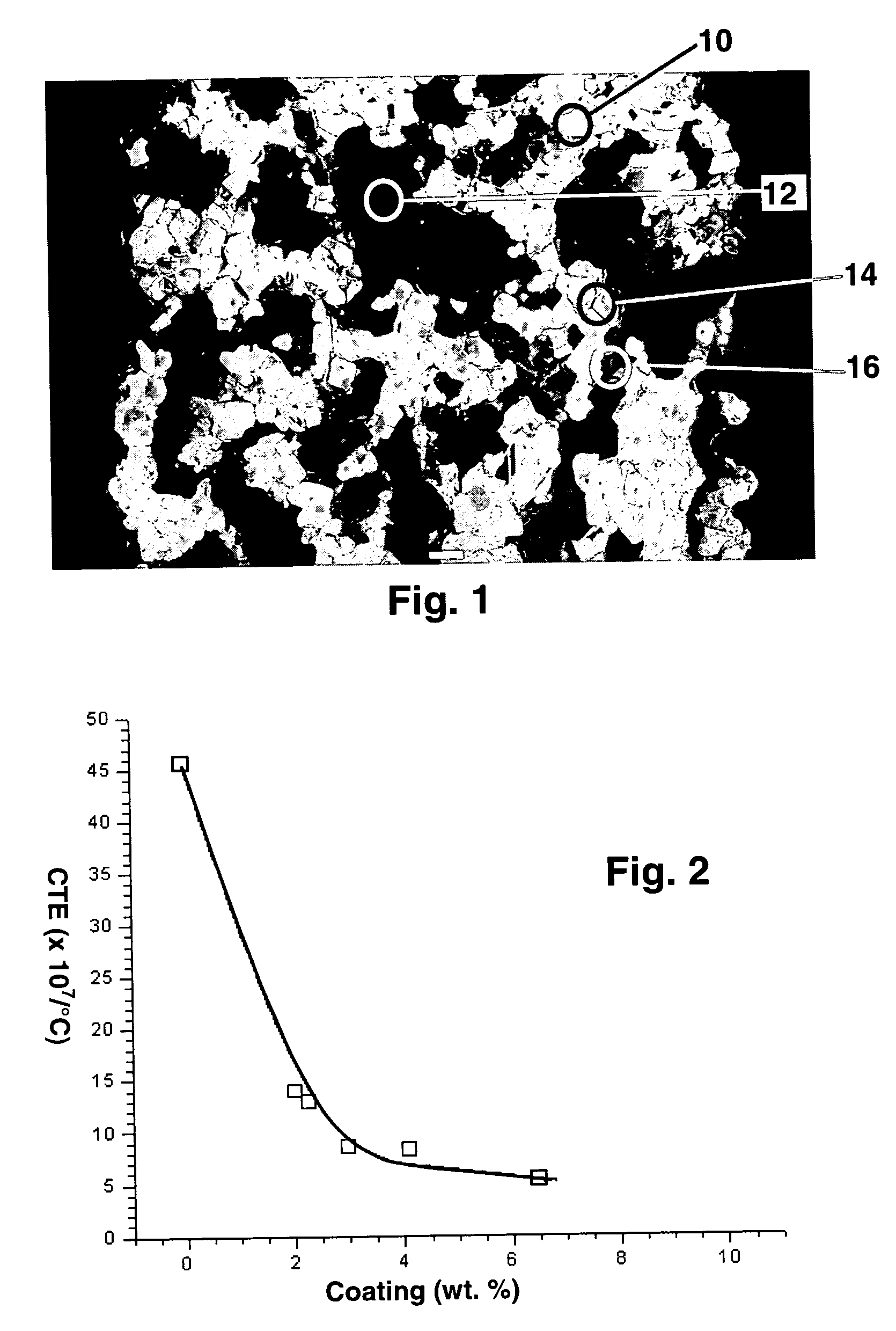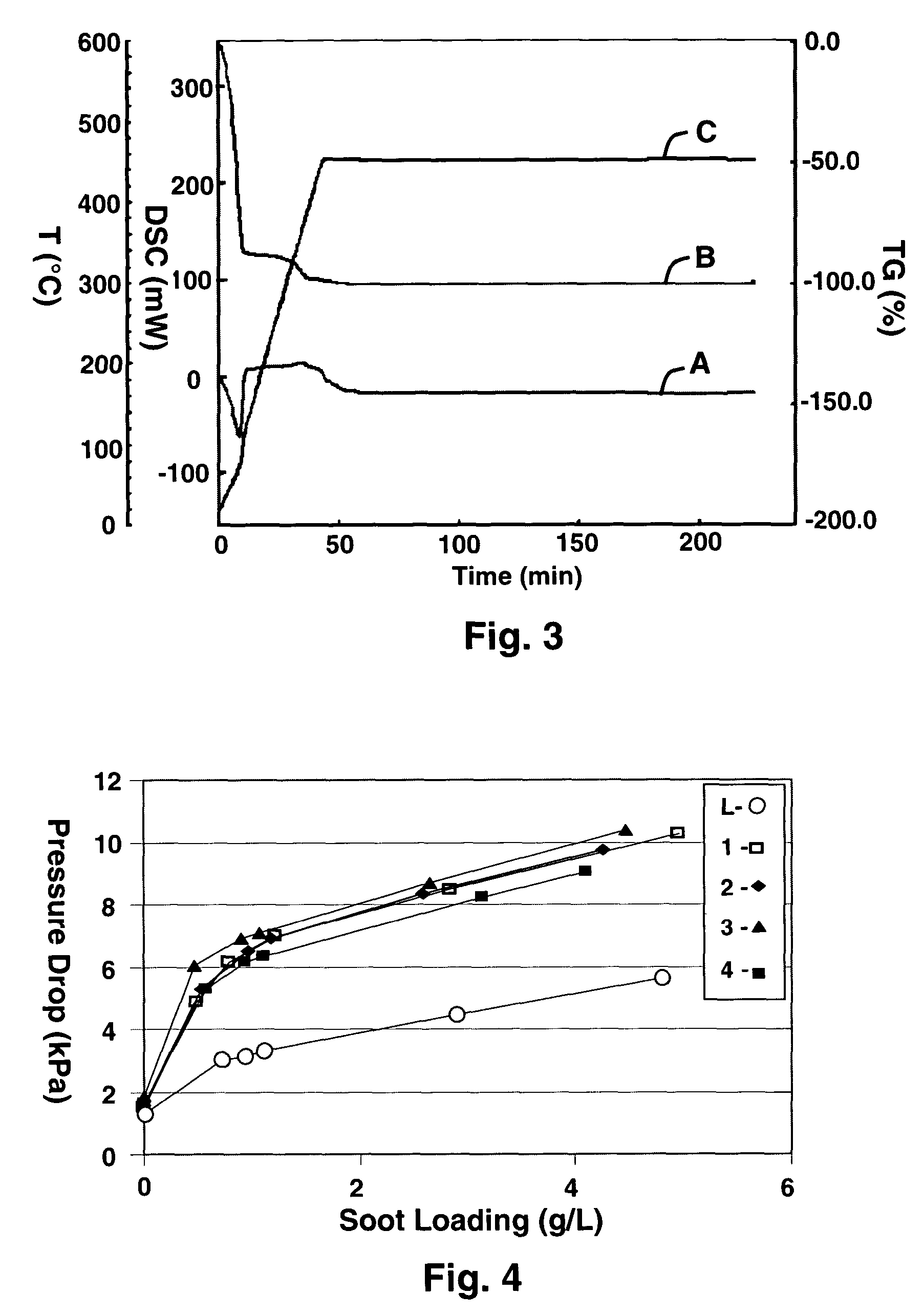Porous ceramic filters with catalyst coatings
a technology of ceramic substrates and catalyst coatings, applied in the direction of catalyst activation/preparation, metal/metal-oxide/metal-hydroxide catalysts, physical/chemical process catalysts, etc., can solve the problem low coefficient of thermal expansion, and the problem of frequent significant increases in cte and filter permeability reductions, etc. problem, to achieve the effect of high gas permeability, high gas permeability, and improved coating efficiency
- Summary
- Abstract
- Description
- Claims
- Application Information
AI Technical Summary
Benefits of technology
Problems solved by technology
Method used
Image
Examples
example 1
Ionene Polymer Barrier Coating
[0045]Aqueous dispersions of Ionene polymers are commercially available, one source being the GE Betz specialty chemical company of Trevose, Pa., USA. The commercial KlarAid™ PC product line from that company comprises aqueous dispersions of water-dispersible propanediyl polymers, sold for use as organic coagulants in a range of molecular weights from below 10,000 to above 170,000. These are supplied as aqueous preparations containing 40–50% polymer solids that can be water-diluted to achieve solids contents in the 1–50% range as needed to modify suspension viscosity and control barrier coating thicknesses on porous ceramic substrates. A specific example is PC 1194 coagulant, a dispersion of the polymer poly[(dimethylimino)(2-hydroxy-1,3-propanediyl) chloride] with a molecular weight of 70,000 and a pH value of 6.1.
[0046]To provide washcoated filter samples using this polymer, a number of ceramic filter samples composed of a porous strontium feldspar (S...
example 2
Aminomethacrylate-Acrylate Copolymer Barrier Coating
[0057]A specific type of acid-activated copolymer present in some commercial water-based acrylic copolymer emulsions is a hydrophobically modified aminomethacrylate-acrylate copolymer such as described above wherein the R groups are of the structural formula:
[0058]
Co-polymers of this structure are commercially available in the form of water-based emulsions, a specific example of one commercial product being Alcogum L-520 alkali-soluble emulsion, sold by the Alco Chemical company of Chattanooga, Tenn., U.S.A. These formulations have pH values in the range of 8–9 and co-polymer solids contents within the range of 6–20%, and are capable of providing passivation layers ranging up to 12% by weight of complex ceramic shapes such as high-geometric-surface area ceramic honeycombs.
[0059]To test the effectiveness of one such preparation a passivating coating mixture based on Alcogum L-520 emulsion (received as a 20% solids by weight) is dilu...
example 3
Ethylene Acrylic Acid Wax Barrier Coating
[0066]Several aluminum titanate filter samples having composition and configuration of the filter samples processed in accordance with Example 1 above are selected for washcoating treatment, and a number of the samples are pre-treated with an aqueous ethylene acrylic acid wax emulsion solution prior to washcoating. The wax emulsion selected to provide this barrier coating is Michem® Prime 4983R Dispersion, commercially available from Michelman, Inc., Cincinnati, Ohio, USA. This product is supplied as an aqueous polymer dispersion comprising about 25% by weight of dispersed ethylene acrylic acid wax of 30 nm average particle size and approximately 30,000 molecular weight. To facilitate coating, the as-supplied emulsion is diluted to 12% solids by weight, and 3% by weight of isopropyl alcohol is added to the diluted suspension to reduce surface tension of the resulting barrier coating solution.
[0067]While this solution is of a viscosity suitabl...
PUM
| Property | Measurement | Unit |
|---|---|---|
| temperature | aaaaa | aaaaa |
| diameters | aaaaa | aaaaa |
| particle size | aaaaa | aaaaa |
Abstract
Description
Claims
Application Information
 Login to View More
Login to View More - R&D
- Intellectual Property
- Life Sciences
- Materials
- Tech Scout
- Unparalleled Data Quality
- Higher Quality Content
- 60% Fewer Hallucinations
Browse by: Latest US Patents, China's latest patents, Technical Efficacy Thesaurus, Application Domain, Technology Topic, Popular Technical Reports.
© 2025 PatSnap. All rights reserved.Legal|Privacy policy|Modern Slavery Act Transparency Statement|Sitemap|About US| Contact US: help@patsnap.com



